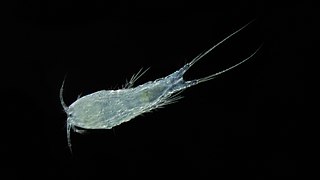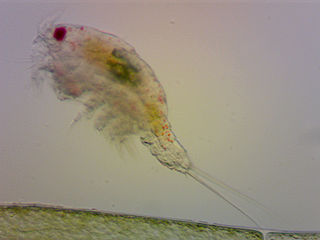At the end of each Major League Baseball season, the league leaders of various statistical categories are announced. Leading either the American League or the National League in a particular category is referred to as a title.

Canthocamptus is a genus of copepods that live in water from the Arctic Ocean to the Atlantic Ocean. There are over 200 different species of Canthocamptus. A number of Australian endemic species are listed as vulnerable species on the IUCN Red List, and one Brazilian species is conservation dependent.
This is a list of players, both past and current, who appeared at least in one game for the Detroit Tigers, with their main position and years played.
The Chicago Cubs baseball club is an original member of the National League, established in 1874 or 1870. Here is a list of players who appeared in at least one regular season game beginning 1874.
The following is a list of players, both past and current, who appeared at least in one game for the Los Angeles Dodgers National League franchise (1958–present), and for the Brooklyn-based teams known as the Atlantics (1884), Grays (1885–1887), Bridegrooms, Grooms (1891–1895), Superbas (1899–1910), Dodgers and Robins (1914–1931).
The following is a list of players, both past and current, who appeared in at least one game for the New York Yankees franchise, including the 1901–02 Baltimore Orioles, and the 1903–12 New York Highlanders.

Attheyella is a genus of copepods in the family Canthocamptidae, containing the following species:
Elaphoidella is a genus of freshwater copepods in the family Canthocamptidae. It contains over 200 species, including three classified as vulnerable species by the IUCN – three endemic to Slovenia and one endemic to the United States. In total, the genus Elaphoidella contains the following species:
Leptocaris is a genus of copepods in the family Darcythompsoniidae. One species, the Mexican endemic L. stromatolicolus, is included on the IUCN Red List as a vulnerable species. The genus contains the following species:
Nitocrella is a genus of copepod. Although most other genera in the family Ameiridae are marine, species of Nitocrella are almost exclusively found in subterranean fresh water or brackish water. More than 80 species are included in the genus, including two which are listed as vulnerable species on the IUCN Red List:

Canthocamptidae is a family of copepods. Most of the 700 species are confined to fresh water, although there are also marine species. It contains the following genera:

Ectinosomatidae is a family of the Harpacticoida, a huge group of crustaceans belonging to the subclass Copepoda. Like most of their relatives, they are usually benthic inhabitants of marine environments. Ectinosomatidae commonly inhabit sediment and fragments of dead corals or glass sponges, and occasionally algae and bryozoans, in the deep oceans. In the epifaunal species, the first leg pair is often modified to allow the animals a better grip on the substrate.
Karllangia is a genus of marine copepods. Its name commemorates the Swedish carcinologist Karl Georg Herman Lang. The genus contains five species:
Robertgurneya is a genus of copepods, containing the following species:
Pontella is a marine copepod genus in the family Pontellidae. It is an organism that bears three lenses in the eye. The outer has a parabolic surface, countering the effects of spherical aberration while allowing a sharp image to be formed.

The Hexanauplia constitute a class of crustaceans, comprising two groups: the Copepoda and the Tantulocarida. The former subclass Thecostraca was elevated to class rank and removed from Hexanauplia in 2021.




